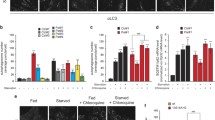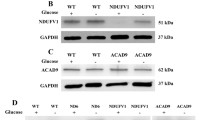Abstract
Abnormal proliferation of mitochondria generally occurs in muscle of aged individuals and patients with mitochondrial myopathy. An increase in the mitochondrial DNA (mtDNA) copy number has also been observed in aging human tissues. However, the molecular mechanism underlying the increase in mitochondrial mass and mtDNA is still unclear. In a previous study, we demonstrated that sublethal levels of oxidative stress caused an increase in mitochondrial mass in human lung cells. In this communication, we report our recent findings that the mitochondrial mass in human lung fibroblasts (MRC-5) in a later proliferation stage is significantly increased compared to that in the early stages of proliferation. The extent of the increase in mitochondrial mass in the senescent cells was similar to that in cells in the early stages of proliferation that had been treated with low concentrations (≤ 180 µM) of hydrogen peroxide (H2O2). Moreover, we found that the rate of reactive oxygen species (ROS) production was higher in cells in the later proliferation stage compared to cells in the early proliferation stages. A similar phenomenon was also observed in cells in the early proliferation stages under low levels of oxidative stress. On the other hand, the mRNA levels of many nuclear DNA-encoded proteins involved in mitochondrial biogenesis, particularly nuclear respiratory factor-1, were found to increase in cells in later proliferation stages and in cells in early proliferation stages that had been treated with 180 µM H2O2. Interestingly, the increase in mitochondrial mass in the cells under oxidative stress could be repressed by treatment with cycloheximide orm-chlorocarbonyl cyanide phenylhydrazone but not by chloramphenicol. Furthermore, the mitochondrial mass of mtDNA-less ρ° cells was also significantly increased by exposure to low concentrations (e.g. 180 µM) of H2O2. These results suggest that the increase in mitochondrial mass in replicative senescent cells may result from an increase in ROS production, and that it is dependent on both de novo synthesis of nuclear DNA-encoded proteins and their import into mitochondria, dictated by the membrane potential of mitochondria.
Similar content being viewed by others
References
Ames BN, Shigenaga MK, Hagen TM. Mitochondrial decay in aging. Biochim Biophys Acta 1271:165–170;1995.
Anderson S, Bankier AT, Barrell BG, de Bruijn MH, Coulson AR, Drouin J, Eperon IC, Nierlich DP, Roe BA, Sanger F, Schreier PH, Smith AJ, Staden R, Young IG. Sequence and organization of the human mitochondrial genome. Nature 290:457–465;1981.
Barrientos A, Casademont J, Cardellach F, Ardite E, Estivill X, Urbano-Marquez A, Fernandez-Checa JC, Nunes V. Qualitative and quantitative changes in skeletal muscle mtDNA and expression of mitochondrial-encoded genes in the human aging process. Biochem Mol Med 62:165–171;1997.
Barrientos A, Casademont J, Cardellach F, Estivill X, Urbano-Marquez A, Nunes V. Reduced steady-state levels of mitochondrial RNA and increased mitochondrial DNA amount in human brain with aging. Brain Res Mol Brain Res 52:284–289;1997.
Bladier C, Wolvetang EJ, Hutchinson P, de Haan JB, Kola I. Response of a primary human fibroblast cell line to H2O2: Senescence-like growth arrest or apoptosis? Cell Growth Differ 8:589–598;1997.
Bogenhagen D, Clayton DA. Mouse L cell mitochondrial DNA molecules are selected randomly for replication throughout the cell cycle. Cell 11:719–727;1977.
Burdon RH. Superoxide and hydrogen peroxide in relation to mammalian cell proliferation. Free Radic Biol Med 18:775–794;1995.
Chance B, Sies H, Boveris A. Hydroperoxide metabolism in mammalian organs. Physiol Rev 59:527–604;1979.
Chen QM, Bartholomew JC, Campisi J, Acosta M, Reagan JD, Ames BN. Molecular analysis of H2O2-induced senescent-like growth arrest in normal human fibroblasts: p53 and Rb control G1 arrest but not cell replication. Biochem J 332:43–50;1998.
Gadaleta MN, Rainaldi G, Lezza AMS, Milella F, Fracasso F, Cantatore P. Mitochondrial DNA copy number and mitochondrial DNA deletion in adult and senescent rats. Mutat Res 275:181–193;1992.
Lander HM. An essential role for free radicals and derived species in signal transduction. FASEB J 11:118–124;1997.
Lee HC, Lu CY, Fahn HJ, Wei YH. Aging- and smoking-associated alteration in the relative content of mitochondrial DNA in human lung. FEBS Lett 441:292–296;1998.
Lee HC, Wei YH. Mitochondrial role in life and death of the cell. J Biomed Sci 7:2–15;2000.
Lee HC, Yin PH, Lu CY, Chi CW, Wei YH. Increase of mitochondria and mitochondrial DNA in response to oxidative stress in human cells. Biochem J 348:425–432;2000.
Lezza AMS, Pesce V, Cormio A, Fracasso F, Vecchiet J, Felzani G, Cantatore P, Gadaleta MN. Increased expression of mitochondrial transcription factor A and nuclear respiratory factor-1 in skeletal muscle from aged human subjects. FEBS Lett 501:74–78;2001.
Luciakova K, Li R, Nelson BD. Differential response of the transcript levels of some nuclear-encoded and mitochondrial-encoded respiratory chain components in response to growth activation. Eur J Biochem 207:253–257;1992.
Mancini M, Anderson BO, Caldwell E, Sedghinasab M, Paty PB, Hockenbery DM. Mitochondrial proliferation and paradoxical membrane depolarization during terminal differentiation and apoptosis in a human colon carcinoma cell line. J Cell Biol 138:449–469;1997.
Moraes CT. What regulates mitochondrial DNA copy number in animal cells? Trends Genet 17:199–205;2001.
Papa S. Mitochondrial oxidative phosphorylation changes in the life span. Molecular aspects and physiopathological implications. Biochim Biophys Acta 1276:87–105;1996.
Pesce V, Cormio A, Fracasso F, Vecchiet J, Felzani G, Lezza AMS, Cantatore P, Gadaleta MN. Age-related mitochondrial genotypic and phenotypic alterations in human skeletal muscle. Free Radic Biol Med 30:1223–1233;2001.
Poyton RO, McEwen JE. Crosstalk between nuclear and mitochondrial genomes. Annu Rev Biochem 65:563–607;1996.
Renis M, Cantatore P, Polosa PL, Fracasso F, Gadaleta MN. Content of mitochondrial DNA and of three mitochondrial RNAs in developing and adult cerebellum. J Neurochem 52:750–754;1989.
Richter C, Gogvadze V, Laffranchi R, Schlapbach R, Schweizer M, Suter M, Walter P, Yaffee M. Oxidants in mitochondria: From physiology to diseases. Biochim Biophys Acta 1271:67–74;1995.
Robin ED, Wong R. Mitochondrial DNA molecules and virtual number of mitochondria per cell in mammalian cells. J Cell Physiol 136:507–513;1988.
Rothe G, Valet G. Flow cytometric analysis of respiratory burst activity in phagocytes with hydroethidine and 2′,7′-dichlorofluorescin. J Leukoc Biol 47:440–448;1990.
Scarpulla RC. Nuclear control of respiratory chain expression in mammalian cells. J Bioenerg Biomembr 29:109–119;1997.
Sen CK, Packer L. Antioxidant and redox regulation of gene transcription. FASEB J 10:709–720;1996.
Shay JW, Pierce DJ, Werbin H. Mitochondrial DNA copy number is proportional to total cell DNA under a variety of growth conditions. J Biol Chem 265:14802–14807;1990.
Shmookler Reis RJ, Goldstein S. Mitochondrial DNA in mortal and immortal human cells. Genome number, integrity, and methylation. J Biol Chem 258:9078–9085;1983.
Sohal RS, Sohal BH. Hydrogen peroxide release by mitochondria increases during aging. Mech Ageing Dev 57:187–202;1991.
Suzuki H, Kumagai T, Goto A, Sugiura T. Increase in intracellular hydrogen peroxide and upregulation of a nuclear respiratory gene evoked by impairment of mitochondrial electron transfer in human cells. Biochem Biophys Res Commun 249:542–545;1998.
Torroni A, Stepien G, Hodge JA, Wallace DC. Neoplastic transformation is associated with coordinate induction of nuclear and cytoplasmic oxidative phosphorylation genes. J Biol Chem 265:20589–20593;1990.
Wallace DC. Diseases of the mitochondrial DNA. Annu Rev Biochem 61:1175–1212;1992.
Wei YH. Oxidative stress and mitochondrial DNA mutations in human aging. Proc Soc Exp Biol Med 217:53–63;1998.
Wei YH, Lee CF, Lee HC, Ma YS, Wang CW, Lu CY, Pang CY. Increase of mitochondrial mass and mitochondrial genome in association with enhanced oxidative stress in human cells harboring 4,977 bp-deleted mitochondrial DNA. Ann NY Acad Sci 928:97–112;2001.
Wei YH, Scholes CP, King TE. Ubisemiquinone radicals from the cytochromeb-c 1 complex of mitochondrial electron transport chain — demonstration of QP-S radical formation. Biochem Biophys Res Commun 99:1411–1419;1981.
Wiesner RJ, Kurowski TT, Zak R. Regulation by thyroid hormone of nuclear and mitochondrial genes encoding subunits of cytochromec oxidase in rat liver and skeletal muscle. Mol Endocrinol 6:1458–1467;1992.
Williams RS. Mitochondrial gene expression in mammalian striated muscle. Evidence that variation in gene dosage is the major regulatory event. J Biol Chem 261:12390–12394;1986.
Williams RS, Salmons S, Newsholme EA, Kaufman RE, Mellor J. Regulation of nuclear and mitochondrial gene expression by contractile activity in skeletal muscle. J Biol Chem 261:376–380;1986.
Author information
Authors and Affiliations
Rights and permissions
About this article
Cite this article
Lee, HC., Yin, PH., Chi, CW. et al. Increase in mitochondrial mass in human fibroblasts under oxidative stress and during replicative cell senescence. J Biomed Sci 9, 517–526 (2002). https://doi.org/10.1007/BF02254978
Received:
Accepted:
Issue Date:
DOI: https://doi.org/10.1007/BF02254978




